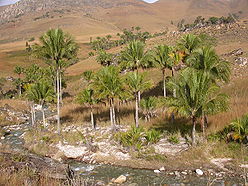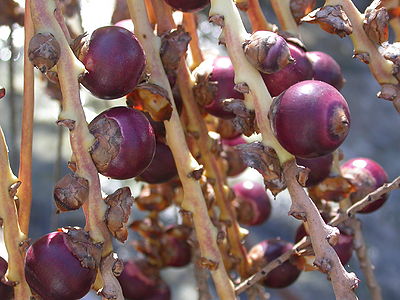Difference between revisions of "Beccariophoenix alfredii"
| Line 62: | Line 62: | ||
</gallery></center> | </gallery></center> | ||
{{SpeciesListBackLink}} | {{SpeciesListBackLink}} | ||
| + | [[Category:Palms of Madagascar]] | ||
[[Category:BECCARIOPHOENIX]] | [[Category:BECCARIOPHOENIX]] | ||
Revision as of 08:58, 28 June 2012
<google>CH02</google>
| Beccariophoenix alfredii | ||||||||
|---|---|---|---|---|---|---|---|---|
 In habitat, Madagascar | ||||||||
| Scientific Classification | ||||||||
| ||||||||
| Synonyms | ||||||||
|
| ||||||||
| Native Continent | ||||||||
|
| ||||||||
| Morphology | ||||||||
| ||||||||
| Culture | ||||||||
| ||||||||
| Survivability index | ||||||||
| ||||||||
| Common names | ||||||||
|
| ||||||||
Beccariophoenix alfredii, also known as the High Plateau Coconut Palm, is a recently discovered species of Arecaceae (palms), endemic to Madagascar. It is in the genus Beccariophoenix, and is closely related to the genus Cocos. Beccariophoenix alfredii is very similar in appearance to the coconut palm, although somewhat cold hardy, making it a good look-alike for the coconut in cooler climates. They are hardy down to about 25°F (-3°C) when young, and likely colder when more mature.
Contents
Taxonomy
Beccariophoenix is placed in the subfamily Arecoideae and the tribe Cocoeae. The species was first noted in 2002, when Alfred Razafindratsira noticed a picture of a Beccariophoenix species in photographs taken of the vegetation surrounding Andrembesoa (originally taken in search of a species of Pachypodium in the rocky escarpments to the southwest of Antsirabe). Alfred found this odd, considering this area of Madagascar is far from the other localities of Beccariophoenix and is, furthermore, ecologically totally different from the east coast and littoral forests where the other Beccariophoenix species are known to occur. In May 2004, an expedition was set off into the High Plateau of Madagascar, to confirm the existence of this species. On the fourth day of the expedition, the new population of Beccariophoenix was found. This species is noted for having oblate (flattened spheroid) rather than ovoid fruit, infrafoliar inflorescence (rather than interfoliar), a peduncle not exceeding 13 cm long (rather than one up to 120 cm long), a 3–5 mm thick leathery peduncular bract which rolls up on when itself when abscised (rather than a heavily lignified peduncular bract 30–40 mm thick, which does not deform when abscised) and 15 stamens (rather than 18-21). For these differences, Beccariophoenix alfredii was classified as a new species. Beccariophoenix alfredii grows up to 50 feet (15 meters) in height with a trunk up to 1 foot (30 cm) in diameter.
Habitat and distribution
Beccariophoenix alfredii occurs in the High Plateau of Madagascar at approximately 20 degrees south. The palm is found at an elevation of 1,050 meters (3,440 feet) growing along the sandy riverbeds. The surrounding vegetation is mainly composed of various grasses, and the area sees occasional fires. Due to the environment that B. alfredii is subjected to, it is hardy against frost and cold, fire, drought, full sun, and possibly hurricanes.
Cultivation
Cultivation, Due to its overall hardiness, B. alfredii is a good candidate for cultivation in central and southern Florida, California and also locations such as Sydney Australia, Southern Spain, Portugal and Northern New Zealand. It is best grown in sandy loam soils, but is suitable to many other soil types. Besides B. alfredii, there are 2 other species of Beccariophoenix: B. madagascariensis, and Beccariophoenix sp. Windows. Beccariophoenix sp. Windows was known for its moderate growth speed, high nutrient requirements and cold sensitivity. Beccariophoenix madagascariensis was known for its cold hardiness and lack of nutritional problems, but had about one-fourth the growth rate of Beccariophoenix sp. Windows. Both species look remarkably similar to the coconut palm when mature, but with a much broader trunk. Beccariophoenix alfredii seems to combine the good characteristics of both, with the growth rate of Beccariophoenix sp. Windows and the cold hardiness and lack of nutritional problems of B. madagascariensis, but B. alfredii has a slimmer trunk, more like that of the coconut palm. All species appear resistant to lethal yellowing, so may be suitable for areas that have a high instance of the disease. Although relatively new to cultivation, B. alfredii is already becoming popular to palm collectors, and is being called the California Coconut of the future. It can be expected that after it is less new to cultivation, it may become extremely popular worldwide due to its coconut look-alike status, good growth rate, and cold hardiness. Although the trunk normally grows straight, it may develop a curve similar to that of the coconut palm if planted on its side when a few years old.
Curiosities
Beccariophoenix alfredii exhibits some window panes in the fronds as a juvenile, although not as many as the window pane version of Beccariophoenix. As a seedling, Beccariophoenix alfredii takes quite a long time to go from monofid leaves to bifid leaves, to bifid leaves with minimal windows to fully pinnate leaves, which is quite different than the "no windows" Beccariophoenix madagascariensis, which undergoes these changes relatively quickly. Therefore, although seedlings of Beccariophoenix alfredii exhibit some similarities to Beccariophoenix madagascariensis, it is quite distinct. Due to the recent discovery of Beccariophoenix alfredii, growth speeds aren't entirely known, but a few things can be gathered from the time it has been known. In tropical and subtropical climates, such as Hawaii or Florida, Beccariophoenix alfredii may be the fastest of the 3 species, but for Mediterranean climates, Beccariophoenix seems to only be marginally faster in growth than the "no windows" Beccariophoenix madagascariensis. These are just educated guesses however, and more time needs to be permitted to allow proper scrutinization on growth rate. Another curiosity is development of "twins" within a single seed. Both seeds can germinate, resulting in a double germinated seed. So far, this appears to be relatively common, but it isn't known whether or not the trait can be inherited.
Windows in Juvenile palms
The photos below, are showing 'windows' in alfredii seedlings. These will be watched as new leaves are produced.
External links
- IMAGE GALLERY
Many Special Thanks to Ed Vaile for his long hours of tireless editing and numerous contributions.








